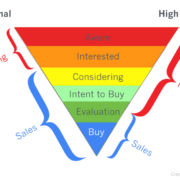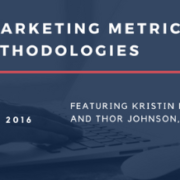Closed-loop marketing represents an evolving challenge for many organizations. While the promise of closed-loop marketing has been with us for over a decade, effective implementation can still be elusive – particularly for larger enterprises that have data and organizational complexities that can impact a smooth implementation.
As part of the architecture for a closed-loop system, it can be very helpful to agree a set of Closed-Loop Marketing Design Principles that can serve to guide decision making around applications, data, technology and processes. We often develop and facilitate agreement of a set of principles across marketing, sales, technology and finance teams. Below are a few examples of Design Principles that can serve as a starting point. These need to be refined and tailored to your organization through a cross-functional facilitation process.

Example Design Principles for Closed-loop Marketing
Cross-functional Alignment
- The CLM solution should be agreed by marketing, sales, finance and technology stakeholders.
- Marketing and sales processes will be aligned to understand and track the life of the lead and continuously evaluate the sales funnel.
- Common requirements should be satisfied through common business functions
- Systems should support multiple business entities and stakeholders must understand & support the change
- The customer buying lifecycle and stages should be agreed by both marketing and sales
- Sales lead qualification should be a collaborative process
- Sales professionals should be equipped to engage prospects into marketing campaigns
- Business value will be achieved through a measured continual improvement approach
- Revenue conversion information should be tracked back to attributed marketing activities
- Analytical capabilities are cross-platform and help to calculate return investment
- Business groups should understand the cost of the IT resources they consume so that they can optimize resources and manage costs.
Customer Audience Engagement
- Audience engagement and communication should consider previous interactions and information
- The digital experience will include controlled and amplified content
- Web systems will help marketing track the life of the lead and be optimized to attract traffic and traffic origins
- Marketing Automation will monitor online consumer/ visitor behaviors
- Automated content delivery can be triggered for specific segments based on specific behaviors or rules.
Systems and Data Management Principles
- Data should be captured once and validated at the earliest possible point
- Ongoing data analysis takes place with each marketing communication
- Systems will support integrated management of multi-channel acquisition programs
- There must be one master source for each item of data
- Only changes made to the master data source are valid
- Changes to local replicas must be synchronized with the master.
Technology & Security Considerations
- We promote technology / system reuse before buy-before build
- Access to IT systems and data should be controlled by role- and location-based authentication and logged
- Entities (users, processes, locations etc.) should be identified by unique credentials
- Components should be based upon open or industry standards and cloud technologies are preferred.
- We shall reject the “best of breed” approach in the interest of timeliness, and interoperability
- A cloud service should provide capacity on demand, from anywhere, on any device, and at any time.










Leave a Reply
Want to join the discussion?Feel free to contribute!